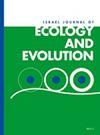Positive association between experimental cortisol increases and cage-measures of feeding behavior in wild-caught gerbils
IF 0.8
4区 环境科学与生态学
Q3 ECOLOGY
引用次数: 0
Abstract
Glucocorticoid hormone levels vary within a forager based upon environmental stressors such as illumination and riskier habitats, and a forager’s response to environmental variables depends upon its glucocorticoid levels. Here, we report on a laboratory experiment in which we manipulated cortisol in Allenbyi’s gerbils (Gerbillus andersoni allenbyi) to test the relationship between cortisol and behavior. We then quantified the resulting blood cortisol levels and feeding behavior in gerbils. Thirty gerbils were injected with 21-day slow-release cortisol pellets drawn from 5 different dosages. We quantified the physiological response to pellet implantation in gerbils by measuring cortisol level in blood serum using ELISA (Enzyme Linked Immunosorbent Assay). We fed gerbils daily by mixing millet seeds into the sand inside rodent cages and measured the remaining seeds the following day to quantify feeding efforts. Some evidence supports that subcutaneous supplementation of glucocorticoids (GCs) in the gerbils led to higher blood serum levels. Cortisol levels varied according to time period of measurement. Gerbils that received lower dosages consumed most of the food presented to them when compared to those receiving the highest doses. In this manner, we delineate a pattern on cortisol hormone level variation over time following dosing and consequences in feeding behavior.实验皮质醇增加与笼中野生沙鼠摄食行为的正相关
觅食者体内的糖皮质激素水平因环境压力源(如照明和风险较高的栖息地)而异,觅食者对环境变量的反应取决于其糖皮质激素的水平。在这里,我们报道了一项实验室实验,在该实验中,我们操纵艾伦比沙鼠(Gerbillus andersoni-Allenbyi)的皮质醇,以测试皮质醇与行为之间的关系。然后,我们量化了沙鼠的血液皮质醇水平和进食行为。30只沙鼠注射了从5种不同剂量中提取的21天缓释皮质醇颗粒。我们通过使用ELISA(酶联免疫吸附测定)测量血清中的皮质醇水平来量化沙鼠对颗粒植入的生理反应。我们每天通过将小米种子混合到鼠笼内的沙子中来喂养沙鼠,并在第二天测量剩余的种子以量化喂养效果。一些证据支持沙鼠皮下补充糖皮质激素(GC)会导致血清水平升高。皮质醇水平随测量时间的不同而变化。与剂量最高的沙鼠相比,剂量较低的沙鼠消耗了提供给它们的大部分食物。通过这种方式,我们描绘了给药后皮质醇激素水平随时间变化的模式以及喂养行为的后果。
本文章由计算机程序翻译,如有差异,请以英文原文为准。
求助全文
约1分钟内获得全文
求助全文
来源期刊

Israel Journal of Ecology & Evolution
环境科学-进化生物学
CiteScore
2.10
自引率
0.00%
发文量
7
审稿时长
>36 weeks
期刊介绍:
The Israel Journal of Ecology and Evolution includes high-quality original research and review papers that advance our knowledge and understanding of the function, diversity, abundance, distribution, and evolution of organisms. We give equal consideration to all submissions regardless of geography.
 求助内容:
求助内容: 应助结果提醒方式:
应助结果提醒方式:


